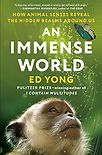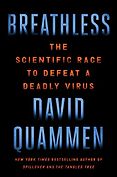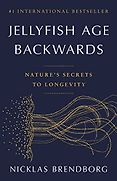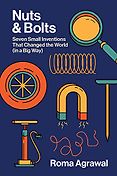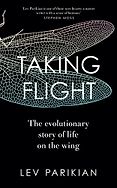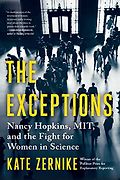For people who don’t know the prize, can you say a bit about it and what kind of books you, as judges, were looking for?
The Royal Society Book Prize is an annual award that’s been ongoing for the past 30 years. It’s had some notable winners, including Stephen Hawking and Bill Bryson. Each year, the award celebrates excellent popular science writing over a broad range of topics.
Topics include physics, geology, neuroscience, psychology, evolution, engineering, and mathematics, among others. The type of science that judges are typically looking for is not overly specific but what we are looking for is a topic that’s written in a compelling way, that can appeal to the general public and excite people about that particular topic.
Let’s start with An Immense World by American science writer Ed Yong. This sounds like an amazing book. Tell me about it and why you liked it.
This was a book I was very excited about when I first saw it. I thought, ‘I must read this!’ It really is an absolutely marvelous read, from start to finish. It’s just very intriguing. It focuses on animal senses—including smell, sight, hearing, and echolocation, among others.
It’s written in a way that truly defines what a great science book is, in that it takes a topic and describes it in a clear scientific manner, but also in a way that really makes the reader think. It really makes you think about all the different senses and all these animals with their amazing senses all around us.
The book opens up the reader to a whole new world. As humans, we use sight as our main sense to interpret the world around us. But for dogs, for example, their main sense is smell. Learning how a dog, and all the other animals discussed in the book, interpret the world around them was truly intriguing.
I also learned about animals that I’d never heard about before. I learned about the star-nosed mole and the fire-chaser beetle, which is really quite amazing. Fire-chaser beetles sense forest fires from miles away and go there to lay their eggs. I really went ‘Wow!’ learning about that.
After finishing the book, I felt I had a new appreciation for the world around me and all the species of animals that inhabit it. It really made me think and understand that we are not the only ones here. It’s quite special.
Let’s turn to Breathless by David Quammen, which is about COVID. Tell me more.
This is a book about the COVID-19 pandemic, but what makes this read unique is that it doesn’t go into the preparedness of countries or how they dealt with COVID-19. Rather, it takes you on a detective-like journey through the science of COVID-19. It looks at the theories on its origins and the scientists who worked relentlessly on understanding the biology of the virus itself and then the development of the vaccines against it. A lot of people think that the vaccine development happened quite fast, me included. However, in reality, RNA-type vaccine technology has been in the works for years. Scientists have been working on mRNA vaccine technology for decades and were then able to take that technology and effectively apply it to COVID-19.
One thing the author does that I found enjoyable is that he includes interviews and conversations with eminent scientists in the field throughout the world. This allows the reader to get their expert opinion on COVID-19.
Again, it’s a very complex topic. He’s talking about the origins and the biology of COVID-19, but the author is able to break that down for the reader. It’s written in a way that’s easily understood which I believe makes this read quite appealing.
The author also writes about the inequality in the world regarding the vaccine and its availability. In the Western world, we were lucky to have access to this vaccine. However, there are a lot of countries that didn’t have that access. The book emphasizes that until the whole world is vaccinated and protected from COVID-19—or any other type of virus—really none of us are because the way these viruses are able to spread is quite scary. I liked that he brought that to our attention.
Does he nail down the origins of COVID-19? Because that’s quite contentious.
No. Based on expert science opinion, it is most likely that the virus had a zoonotic origin in bats, possibly via an intermediate host, but there’s no conclusive answer.
Let’s go on to Jellyfish Age Backwards by Nicklas Brendborg. This is a book about longevity, I think.
The title of the book is what initially grabbed my attention. The idea is that when jellyfish are exposed to any type of stressor, they go back to their polyp form, eventually budding again to produce a genetically identical jellyfish. Essentially, they can retreat back to their former self and hide in response to stressors and then regrow again into their adult form when the time is right. This is quite amazing. The author uses this premise to talk about the process of aging. There’s a lot of research going on nowadays, about how we can slow down the aging process and what we can do to advance our lives.
It’s great. He’s a young author who is, I believe, a PhD student in Denmark. He really brings in a lot of humor throughout the book as he writes about some of the nonsense science that has been put out there about anti-aging.
He talks about hormesis. This is defined as a phenomenon in which exposing your body to harmful stimuli, including stress, can actually be beneficial. Our body almost becomes trained and develops defenses to protect us from the different stressors. This is the idea behind ice baths, which induce cold water hormesis, which may allow for better recovery etc. He talks about different types of diets, such as intermittent fasting and how that may be protective. He looks at the different studies that have shown the protective effects of diet on anti-aging.
This book is presented in a very clear manner. It’s a very easy read and introduces the reader to the different advances in research on anti-aging. I think it’s a book that will appeal to everyone. The title will make you pick it up and go, ‘Oh, what’s this about?’ and then: ‘Oh! This theme is interesting!’
Now we’re at Nuts and Bolts by Roma Agrawal. This is about engineering, which I was pleased to see because it’s a subject that can be neglected.
Yes, and that’s partly why this book grabbed the attention of the judges. The number of books about engineering on the longlist was very sparse. It’s also by a woman engineer, which is exciting.
What she looks at is apparently quite mundane types of engineering developments over the centuries or even millennia. There is one chapter on the nail and another one on the wheel. You think, ‘How am I going to read a chapter about a nail?’ but the author discusses how many objects we use all the time couldn’t actually function without the discovery of the nail.
She discusses seven of these engineering developments that we never think about, and makes you as a reader go, ‘Oh, my gosh! Society as we know it would not be the same without these discoveries.’
It was a captivating read. I also really enjoyed how the author brought in her own personal experiences, and how some of these discoveries impacted her life. For example, she has a chapter on the discovery of the lens, which in turn allowed for the development and advancement of IVF. I thought that was quite amazing. She showed how something so simple has such huge implications for individuals.
She adds a lot of humor and bits of food for thought for the reader in each of the chapters. There are also cool little graphical images scattered throughout. This enables a nice visualization of the different objects being described. My take-home message is that this is a book that everybody should read if they’re interested in learning about the world around us. For me personally, I feel I have a greater appreciation for these so-called mundane objects that allow us to function in our daily lives.
Next, tell me about Taking Flight by Lev Parikian.
This was another one that caught the attention of all the judges. It’s a book about the evolution of flying. From a scientific point of view, it’s a really interesting topic and the author communicates it in a very educational, but also an entertaining and engaging manner.
Each chapter focuses on a different type of bird or flying mammal. For example, there’s one chapter on bats and another on hummingbirds. One interesting thing that I learned about the hummingbird that I didn’t know before, is that it has a hippocampus—the part of the brain that is involved in our ability to store memories—and uses it to remember the flowers with the best pollen. They fly around to the different flowers and memorize which ones are good and which ones less so.
The book reminds you that we’re not the only ones here on the planet. There are other animals and creatures out there that are living their lives. As a result of reading this book, I’m more aware of, and will take more time to appreciate, all the flying birds, insects and creatures around us.
And for anyone who wants to learn a bit more about all these different birds and creatures, this book will present it to you in a very clear, scientific manner, which is very important. The author also adds in lots of bits of humor throughout, which makes it an easy read, because if it were just a completely scientific read about the evolution of flying that could be quite difficult to get through. But this book really is a page-turner, actually.
Let’s turn to the last book, The Exceptions by Kate Zernike, which tells a tale of the challenges facing women in science.
This book is about the life and work of Nancy Hopkins, who is a molecular biology professor in the United States. It focuses on the discrimination that she went through as a young woman scientist in the 1960s and 70s in the United States. It’s specifically focused on MIT/Harvard, because that’s where she did most of her work.
This book really struck me on a personal level, reading it and learning about the struggles of women in science, because I’m a woman in science too. There were many hard-won—and hard-lost—battles for women in research to get recognition and equal treatment with men.
The book focuses on Nancy Hopkins but also describes the work and lives of other women she worked with, who really fought to get equal treatment for women in science. The groundwork they did at MIT transferred to other universities in the United States and from there around the world.
It was really a book that I didn’t want to put down. It’s a very exciting, easy read. It’s written in a very elegant way. There are personal accounts, there are historical aspects and also different scientific aspects all interwoven throughout the chapters. It’s a book that will appeal to everyone and I don’t think you have to have a particular interest in science to enjoy this book.
The end is quite topical. The last chapter mentions Katalin Karikó, who is the Hungarian-American scientist whose work on messenger RNA helped pave the way for the COVID-19 vaccine. She worked for years in research institutes in America. She didn’t get tenure, she got fired, she didn’t get equal treatment with men, but she continued to preserve. She now is a recipient of the Nobel Prize in Physiology and Medicine.
This book really sums up the perseverance of these women to get the recognition that they deserve within their work, while also paving the way for other young women scientists out there. It would be an important read, for young girls and women. For me, these are the women who should be the true role models for young girls and women out there. It’s a truly powerful book.
Interview by Sophie Roell, Editor
November 21, 2023. Updated: January 19, 2024
Five Books aims to keep its book recommendations and interviews up to date. If you are the interviewee and would like to update your choice of books (or even just what you say about them) please email us at [email protected]
Five Books interviews are expensive to produce. If you've enjoyed this interview, please support us by donating a small amount.

